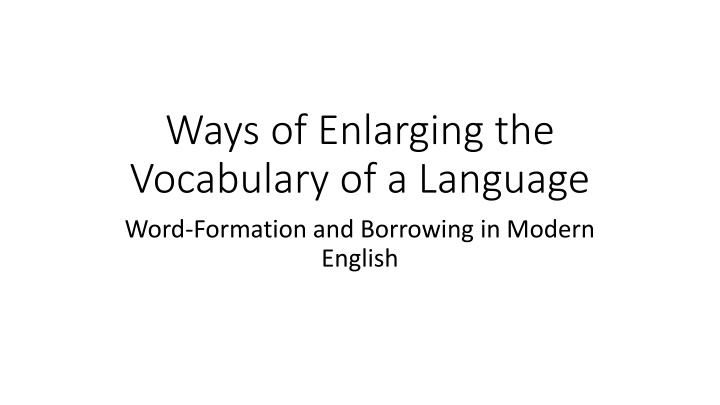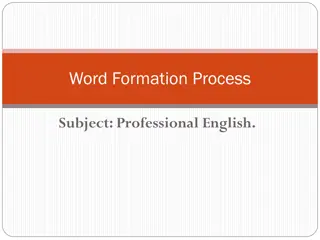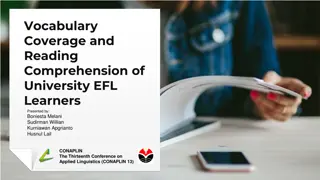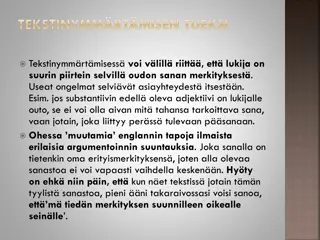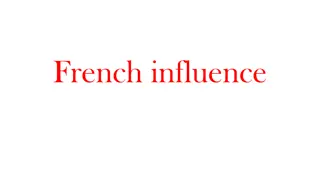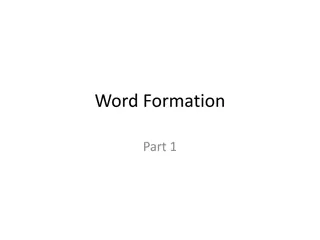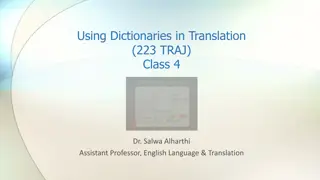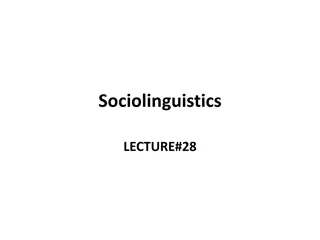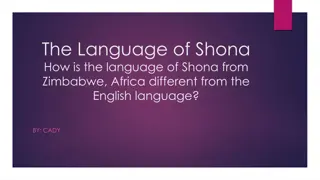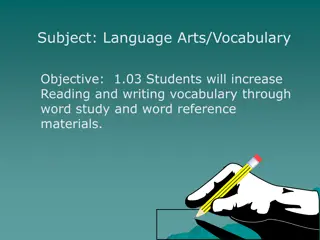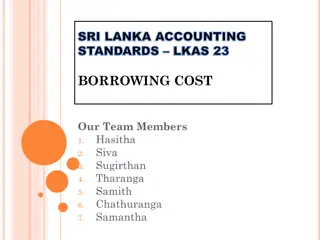Ways of Enlarging the Vocabulary of a Language Word-Formation and Borrowing in Modern English.
Explore various types of word-building processes in Modern English, including morphological, syntactic, and mixed methods like affixation, composition, conversion, and borrowing. Understand the classifications of affixes, techniques in morphological word-building, and the diversity of the English vocabulary due to borrowings.
Download Presentation

Please find below an Image/Link to download the presentation.
The content on the website is provided AS IS for your information and personal use only. It may not be sold, licensed, or shared on other websites without obtaining consent from the author.If you encounter any issues during the download, it is possible that the publisher has removed the file from their server.
You are allowed to download the files provided on this website for personal or commercial use, subject to the condition that they are used lawfully. All files are the property of their respective owners.
The content on the website is provided AS IS for your information and personal use only. It may not be sold, licensed, or shared on other websites without obtaining consent from the author.
E N D
Presentation Transcript
Ways of Enlarging the Vocabulary of a Language Word-Formation and Borrowing in Modern English
Outline 1. Types of word-building 2. Affixation. Classifications of affixes 3. Composition. Classification of compounds 4. Conversion as a means of word-formation 5. Minor types of word-building 6. The Etymological Diversity of the English Vocabulary 7. Classification of Borrowings According to Degree of Assimilation 8. Foreign elements in Modern English
Types of word-building Word-formation is the process of creating new words according to certain structural and semantic patterns specific for the given language. Types of word-building: morphological syntactico-morphological syntactical
Morphological word-building Morphological word-building is characterised by a change in morphological structure of a word. It comprises: affixation word-composition (compounding) shortening change of stress reduplication sound gradation blending
Syntactico-morphological word-building Syntactico-morphological word-building both morphological and syntactical features of the word are changed. It comprises juxtapositional word-composition conversion substantivation lexicalization of the plural of nouns
Syntactical word-building Syntactical word-building is represented by one type syntactical word-composition
Productive and non-productive types of word-formation Productive Non-productive affixation Blending word-composition Reduplication conversion onomatopoeia shortening Sound interchange Change of stress
Affixation. Classifications of affixes prefixation Classifications of affixes: 1. Part-of-speech classification: a) noun-forming affixes (criticiser, ageism), b) adjective-forming affixes (readable, joyful, lucky, breathless, prestigious), c) verb-forming affixes (economise, beautify, sweeten, enact, befriend), d) adverb-forming affixes (frankly, homeward, clockwise), e) numeral-forming affixes (fifteen, sixty, seventh). suffixation (more productive)
Classifications of affixes 2. Semantic classification. Affixes changing the lexical meaning of the stem can be subdivided into groups: Noun-forming suffixes can denote: a) the agent of the action (speaker, student, activist), b) nationality (Belgian, Chenese, English, Ukrainian), c) collectivity (kingdom, peasantry, readership), d) diminutiveness (girlie, booklet, gooseling, kitchenette), e) quality (hopelessness, creativity).
Classifications of affixes Adjective-forming suffixes denote: a) capacity, fitness or worthiness to be acted upon, able to, liable to: -able, -ible, - capable, readable, eligible b) a certain degree of some quality: -ish, grayish, redish c) the presence of quality: - ful, -ous, beautiful, marvelous d) the absence of quality: -less fearless Adverb-forming suffixes denote: a) the manner of action: -ly, quickly b) course or direction to, motion or tendency toward: -ward, -wards toward, backward
Classifications of affixes English prefixes are grouped in the following way (the major groups): a) those of negative meaning (dis- - disloyal); b) those denoting words with the opposite meaning or with the meaning of repetition of some action (un-, re- undress, remake); c) those denoting space, time and other relations (pre- - prewar).
Classifications of affixes 3. Origin of affixes. a) native, such as un-, mis-, -er, -ing, -ful, -less, -ly. b) Romanic, such as: -tion, -ment, -able, -eer. c) Greek, such as: anti-, mega-, ultra-, pro-, re-,-ist, -ism, -ise. d) Russian, such as -nik. 4. Productivity. a) productive, such as : -er, -ise, -ly, -ness, -y, -al. b) semi-productive, such as : -eer, -ette, -ward, -ee. c) non-productive, such as : be-, -ard, -th, -hood, -en.
Splinters Splinters = pseudomorphemes result from clipping the initial or the final part of a word and creating new words analogous to the primary word-group miniplane, minicycle, minivan Eurocard, Euromarket beefburger , cheeseburger , fishburger workaholic, coffeeholic, chocoholic
Composition (compounding) Compounds are words coined by combining two or more stems which exist in the language as free forms. According to the type of composition, compounds may be classified into three groups: 1. Morphological word-composition (with the linking element) : e.g. handicraft, salesgirl, Anglo-Saxon, speedometer. 2. Juxtapositional word-composition (without any linking element): notebook, bittersweet, workroom. 3. Syntactic compounds appear as a result of two processes: 1) lexicalization of a phrase (the initial phrase undergoes certain structural changes: e.g. The boy is working hard a hard-working boy); 2) integration of a phrase (the source phrase does not undergo any structural changes, e.g. middle of the road middle-of-the-road, up to date up-to-date).
Classification of compounds According to the structure of their immediate constituents, compounds fall into: a) compounds consisting of simple stems: bookshelf, snow-white, b) compounds where one of the constituents is derived: snowcovered, many-sided, c) compounds consisting of one simple stem and one clipped stem: X-mas, V-day, d) compounds where one of the ICs is a compound stem: newspaper-ownership. From the point of view of their lexico-grammatical characteristics, compounds fall into: - compound nouns: baby-sitter, looking-glass, - compound verbs: to tip-toe, to nick-name, - compound adjectives: good-looking, ill-dressed.
Compounds The structural unity of a compound word depends upon: a) the unity of stress, b) hyphenated or solid spelling, c) unity of morphological and syntactical functioning, d) semantic unity
Conversion Conversion is the word formation process in which a word of one grammatical form becomes a word of another grammatical form without any changes to spelling or pronunciation, e.g. an email to email Conversion is a morphological way of forming words when one part of speech is formed from another part of speech by changing its paradigm, without any violation of the initial form of the word, e.g. a head to head (the paradigm of the noun (a head, heads) is changed for the paradigm of a regular verb (I head, he heads, headed, heading).
Substantivation Substantivation is the process of coining new words in which adjectives or participles acquire the paradigm of nouns and their syntactic functions. The two main types of substantivation are complete substantivation, e. g. a musical performance a musical (elliptical phrase). partial substantivation, e. g. the poor, the British Partially substantivized adjectives (PSA) fall into the following groups: a) singular in form though plural in meaning: the poor, the British b) plural in form and denoting a group or a class of people: blacks, greens c) plural in form and denoting inanimate things: sweets, eatables d) PSA presenting properties as substantive abstract notions: the good, the evil e) PSA denoting languages: English, German
Shortening Two ways of shortening: contraction (clipping) and abbreviation (initial shortening). Clipping is the word formation process in which a word is reduced or shortened without changing the meaning of the word. The four types of clipping are: 1) apocope (back clipping) is removing of the final part of the word: lab (< laboratory), vocab (< vocabulary), ad (< advertisement) 2) apheresis (fore-clipping) is removing of the initial part of the word: plane (< aeroplane), Tony (< Anthony), Fred (< Alfred) 3) syncope (middle clipping) is removing or retaining only the middle of a word as in flu (< influenza), fridge (< refrigerator), maths (< mathematics) 4) complex clipping is removing multiple parts from multiple words as in sitcom (< situation comedy), abfab (< absolutely fabulous), hazmat (< hazardous material).
Abbreviations Abbreviations are words produced by shortening the ICs of phrasal terms up to their initial letters. They are subdivided into 5 groups: 1) Acronyms which are read in accordance with the rules of orthoepy: NATO [neiteu] < North Atlantic Treaty Organization; AIDS [eidz] < Acquired Immune Deficiency Syndrome; ASAP [eisep] < as soon as possible 2) Alphabetic abbreviations in which letters get their full alphabetic pronunciation and a full stress: CEO (< Chief Executive Officer), (< British Broadcasting Corporation), FBI (< Federal Bureau of Investigation). 3) Compound abbreviations in which the first IC is a letter and the second a complete word: E- mail (electronic mail), L-driver (learner-driver), G-man (Government man). One or both ICs of compound abbreviations may be clipped: Interpol (< International Police), wi-fi (< wireless fidelity). 4) Graphic abbreviations which are used in texts for economy of space: N (noun), ltd (limited), Fri (Friday), X-mas (Christmas). They are pronounced as the corresponding unabbreviated words. 5) Latin abbreviations: e.g. for example, i.e. that is, P.S. post scriptum, B.C. before Christ, A.D. Anno Domini, etc. et cetera
Blending Blending is the creation of new lexical units in which parts of two or more words combine to create a new word: e.g. motel (motorist + hotel), brunch (breakfast + lunch), Spanglish (Spanish + English), cyborg (cybernetic + organism), webinar (web + seminar), the elements of one word are combined with a notional word: docudrama (documentary + drama), etc. The meaning of the new word is a combination of the meanings of the original words.
Reduplication Reduplication is creating a new word by means of complete or partial repetition of the same stem: bye-bye, fifty-fifty, tick-tick, etc. Lexicalization of the plural of nouns is the case when the grammatical form of the plural of nouns becomes isolated from the paradigm and acquires a new lexical meaning, e.g. colours as a plural noun denotes a flag , looks as a plural noun means apperance , attentions denotes courtship, flirtation . Sound imitation (onomatopoeia, echoism) is the creation of words by means of imitating the natural sounds produced by living beings as well as by inanimate objects. According to the source of sound onomatopoeic words semantically fall into several groups. - verbs denoting sounds produced by human beings in expressing their feelings (babble, chatter, giggle, murmur, whisper). - sounds produced by animals, birds and insects (buzz, croak, crow, hiss, howl, mew, purr, roar, twitter). - verbs imitating the noise of inanimate objects: water (bubble, splash), metallic things (clink, tinkle) or by forceful motion (bang, crack, crash, whack, whip).
Sound and stress interchange Sound interchange is the way of word-building when some sounds are changed to form a new word, e.g. to bleed blood, to sing song, hot to heat, bath to bathe, life to live, etc. Words belonging to different parts of speech may be differentiated due to the sound interchange in the root: breathe (v) :: breath (n), wide (adj) :: width (n), long (a) :: length (n) . Change of stress (the shift of stress, stress interchange) : nouns have the stress on the first syllable and verbs on the last syllable, e.g. present (n) :: to pre sent (v), impact (n) :: to im pact (v), object (n) :: to ob ject (v), import (n) :: to import (v).
The Etymological Diversity of the English Vocabulary Etymologically the vocabulary of the English language comprises two layers the native words and the borrowed words (borrowings or loan words). A native word is a word which belongs to the original English stock and is known from the earliest Old English manuscripts the native words are the most frequent words used in speech and writing words of the native stock have a wider range of lexical and grammatical valency, they are very productive and polysemantic
The Etymological Diversity of the English Vocabulary native words are subdivided into 1) those belonging to the Indo-European stock (have cognates in the vocabularies of most Indo-European languages,) 2) those belonging to the common Germanic origin (have cognates only in Germanic languages)
The Etymological Diversity of the English Vocabulary Borrowed words (or loan words or borrowings) are words taken over from another language and modified in accordance with the standards of the English language. Borrowings from various foreign languages, mainly Latin, French, and Scandinavian comprise about 70 % of the English vocabulary. Borrowing is a result of cultural contacts between language communities.
The degree of assimilation depends upon the length of period during which the word has been used in the receiving language frequency communication purpose
According to the degree of assimilation borrowings can be According to the degree of assimilation borrowings can be classified into classified into 1) completely assimilated borrowings (denizens) that follow English phonetical, grammatical and graphic standards and do not seem foreign in origin, e.g. face, chair, street, table, finish,, etc.; 2) partially assimilated borrowings (aliens) which fall into four subgroups; 3) unassimilated borrowed words and phrases (barbarisms) which preserve their original spelling and other characteristics, always have corresponding English equivalents, and, therefore, are not indispensable in English, e.g. addio, ciao, coup d etat, persona grata, etc.
Partially assimilated borrowings a) not assimilated semantically (denote objects, notions peculiar to the country from which they come), e.g. rajah, hryvna, shah, sari, etc.; b) not assimilated grammatically, e.g. nouns of Latin or Greek origin which retain their original plural forms: crisis crises, formula formulae, phenomenon phenomena, etc.; c) not assimilated phonetically, e.g. regime, foyer, memoir, restaurant; d) not assimilated graphically, e.g. clich , blitzkrieg, bouquet, na ve;
Foreign elements in Modern English The Celtic Element in the English Vocabulary The Scandinavian element in the English vocabulary Borrowings from Latin and Greek Borrowings from French Other elements in the English vocabulary
Reference literature 1. . . . : , 2003. 160 c. 2. . . . : , 2009. 128 . 3. . ., . . : . : , 2021. 144 . 4. Crystal D. The Cambridge Encyclopedia of the English Language. Cambridge University Press, 1995. 498 p. 5. Kveselevich D.I., Sasina V.P. Modern English Lexicology in Practice. : - . . , 2000. 117 p. 6. Kvetko P. English Lexicology in Theory and Practice. Trnava, 2005. 203 p. 7. Nikolenko A.G. English Lexicology. Theory and Practice. Vinnytsya: Nova Knyha, 2007. 528 . 8. Rayevska N. M. English Lexicology. K.: , 1979. 293 .
